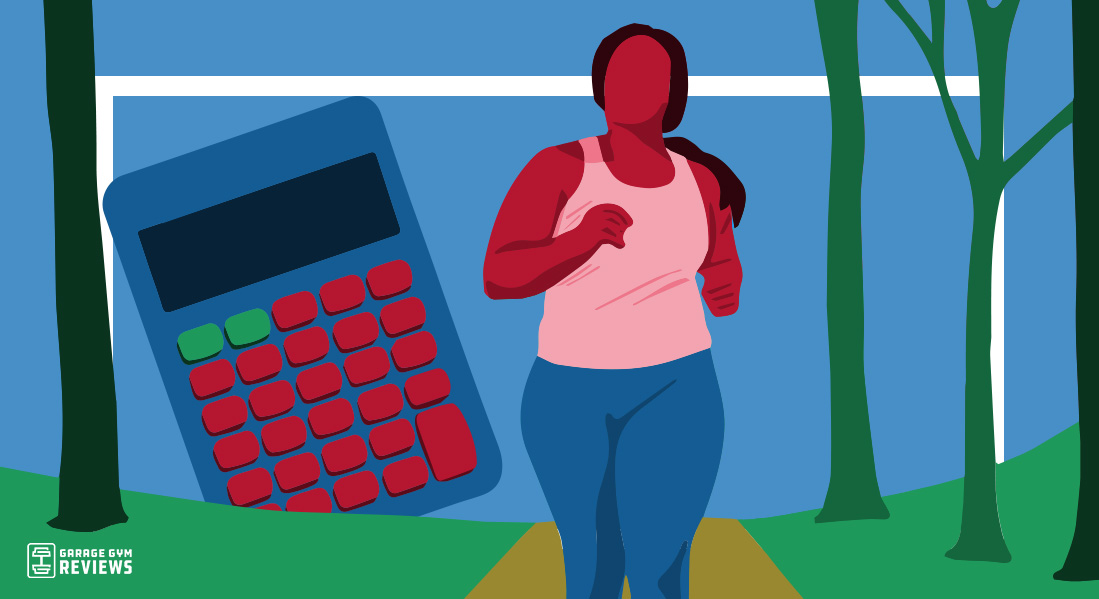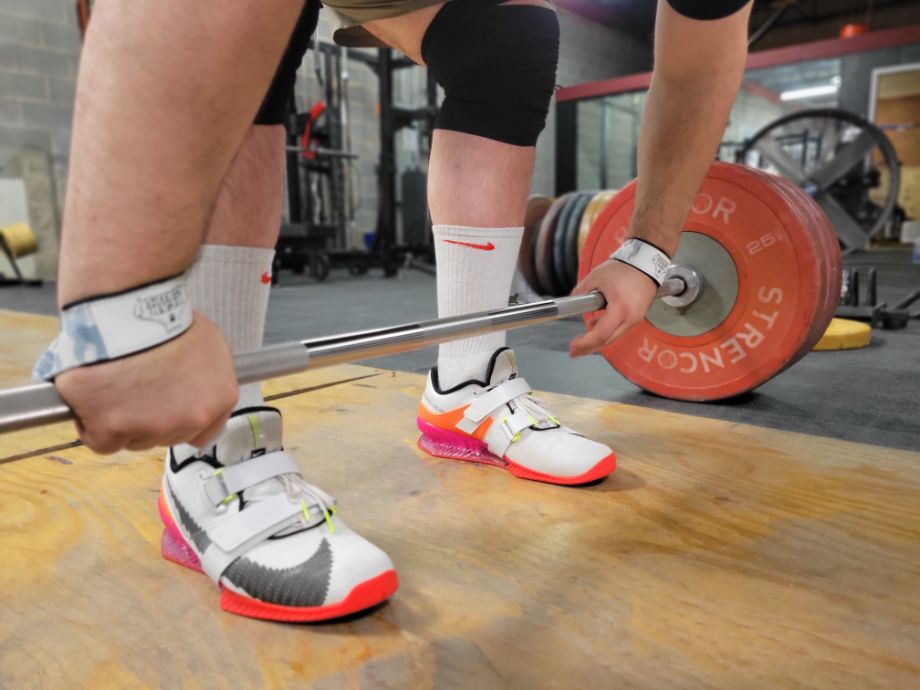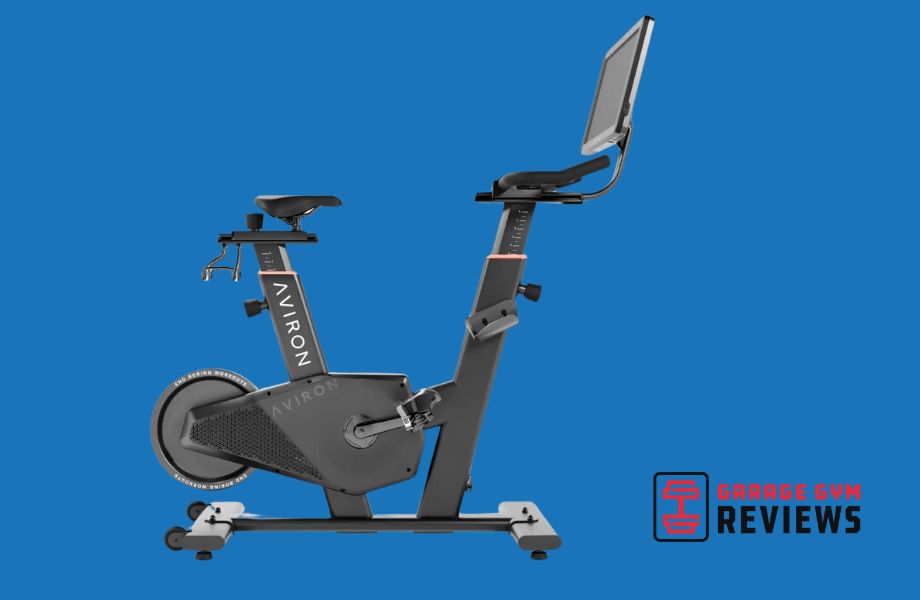Find Out How Many Calories You Can Burn While Walking One Mile
“Take a walk!” might not be the warmest phrase to catch on the receiving end. But maybe it could and should be reframed to a term of endearment thanks to the calorie burn and other perks walking offers.
So, “take a walk” with us as we explore, “How many calories does walking a mile burn?” As we near the finish line, you might even start to appreciate what walking can do for you beyond burning calories!
How Many Calories Does Walking Burn?
We know not many people like this answer, but it depends—specifically, it depends on your body weight. A 155-pound person will burn 133 calories during a 30-minute walk at a 3.5 miles-per-hour pace, compared to a 125-pound person who will burn 107 calories walking at the same pace and distance, according to a 2021 Harvard Health review1.
Think of your body as a wagon. Heavier wagons require more energy to push than a lighter wagon, which is why a heavier person will burn more calories.
That said, there are many other factors that determine how many calories you may burn on a walk.
To determine the average calories burned walking a mile, three different metrics were plugged into Cornell University’s METS to Calories Calculator, including MET values, walking time, and weight:
- METs, abbreviated as metabolic equivalents, help measure energy expenditure by assigning activities with a numerical value based on intensity. We selected MET values in the Compendium of Physical Activity based on common walking speeds.
- Walking time reflects how long it takes to walk a mile at a given pace, such as walking at a 3.0 mph pace would equate to a 20-minute mile.
- Because body weights vary greatly, we used the average male weight of 199.8 pounds and female weight of 170.8 pounds according to the Centers for Disease Control and Prevention (CDC)2.
To keep other factors as consistent as possible, all calculations are based on walking on a firm surface, such as pavement, as well.
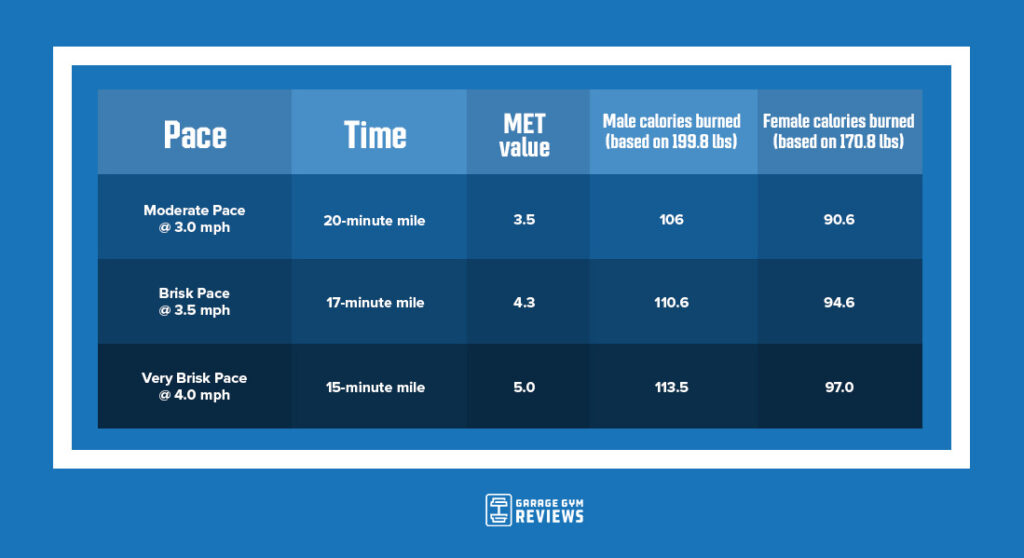
| Pace | Time | MET Value | Male Calories Burned (based on 199.8 lbs) | Female Calories Burned (based on 170.8 lbs) |
|---|---|---|---|---|
| Moderate pace at 3.0 mph | 20-minute mile | 3.5 | 106 | 90.6 |
| Brisk pace at 3.5 mph | 17-minute mile | 4.3 | 110.6 | 94.6 |
| Very brisk pace at 4.0 mph | 15-minute mile | 5.0 | 113.5 | 97.0 |
Calories Burned While Walking At a 2.5 to 3.5 MPH Pace
| Weight (lbs) | 100 | 120 | 140 | 160 | 180 | 200 | 220 | 250 | 275 | 300 |
| Mile 1 | 53 | 64 | 74 | 85 | 96 | 106 | 117 | 133 | 146 | 160 |
| Mile 2 | 106 | 128 | 149 | 170 | 191 | 213 | 234 | 266 | 292 | 319 |
| Mile 3 | 160 | 191 | 223 | 255 | 287 | 319 | 351 | 399 | 439 | 479 |
| Mile 4 | 213 | 255 | 298 | 340 | 383 | 425 | 468 | 532 | 585 | 638 |
| Mile 5 | 266 | 319 | 372 | 425 | 479 | 532 | 585 | 665 | 731 | 798 |
| Mile 6 | 319 | 383 | 446 | 510 | 574 | 638 | 702 | 798 | 877 | 957 |
| Mile 7 | 372 | 447 | 521 | 595 | 670 | 744 | 819 | 931 | 1023 | 1117 |
| Mile 8 | 426 | 510 | 595 | 680 | 766 | 850 | 936 | 1064 | 1170 | 1276 |
| Mile 9 | 479 | 574 | 670 | 765 | 861 | 957 | 1053 | 1197 | 1316 | 1436 |
| Mile 10 | 532 | 638 | 744 | 850 | 957 | 1063 | 1170 | 1330 | 1462 | 1595 |
| Mile 13.1 | 697 | 836 | 975 | 1114 | 1254 | 1393 | 1533 | 1742 | 1915 | 2089 |
| Mile 26.2 | 1394 | 1672 | 1949 | 2227 | 2507 | 2785 | 3065 | 3485 | 3830 | 4179 |
Calories Burned while Walking At A 4 MPH Pace
| Weight (lbs) | 100 | 120 | 140 | 160 | 180 | 200 | 220 | 250 | 275 | 300 |
| Mile 1 | 57 | 68 | 80 | 91 | 102 | 114 | 125 | 142 | 156 | 171 |
| Mile 2 | 114 | 136 | 159 | 182 | 205 | 227 | 250 | 284 | 313 | 341 |
| Mile 3 | 170 | 205 | 239 | 273 | 307 | 341 | 375 | 426 | 469 | 512 |
| Mile 4 | 227 | 273 | 318 | 364 | 409 | 454 | 500 | 568 | 625 | 682 |
| Mile 5 | 284 | 341 | 398 | 455 | 512 | 568 | 625 | 710 | 782 | 853 |
| Mile 6 | 341 | 409 | 477 | 545 | 614 | 682 | 750 | 852 | 938 | 1023 |
| Mile 7 | 398 | 477 | 557 | 636 | 716 | 795 | 875 | 994 | 1094 | 1194 |
| Mile 8 | 454 | 546 | 636 | 727 | 818 | 909 | 1000 | 1136 | 1250 | 1364 |
| Mile 9 | 511 | 614 | 716 | 818 | 921 | 1022 | 1125 | 1278 | 1407 | 1535 |
| Mile 10 | 568 | 682 | 795 | 909 | 1023 | 1136 | 1250 | 1420 | 1563 | 1705 |
| Mile 13.1 | 744 | 893 | 1041 | 1191 | 1340 | 1488 | 1638 | 1860 | 2048 | 2234 |
| Mile 26.2 | 1488 | 1787 | 2083 | 2382 | 2680 | 2976 | 3275 | 3720 | 4095 | 4467 |
Calories Burned while Walking At A 4.5 MPH Pace
| Weight (lbs) | 100 | 120 | 140 | 160 | 180 | 200 | 220 | 250 | 275 | 300 |
| Mile 1 | 64 | 76 | 89 | 102 | 115 | 127 | 140 | 159 | 175 | 191 |
| Mile 2 | 127 | 153 | 178 | 204 | 229 | 255 | 280 | 318 | 350 | 382 |
| Mile 3 | 191 | 229 | 267 | 305 | 344 | 382 | 420 | 477 | 525 | 573 |
| Mile 4 | 254 | 306 | 356 | 407 | 458 | 509 | 560 | 636 | 700 | 764 |
| Mile 5 | 318 | 382 | 446 | 509 | 573 | 637 | 700 | 796 | 875 | 955 |
| Mile 6 | 382 | 458 | 535 | 611 | 687 | 764 | 840 | 955 | 1050 | 1145 |
| Mile 7 | 445 | 535 | 624 | 713 | 802 | 891 | 980 | 1114 | 1225 | 1336 |
| Mile 8 | 509 | 611 | 713 | 814 | 916 | 1018 | 1120 | 1273 | 1400 | 1527 |
| Mile 9 | 572 | 688 | 802 | 916 | 1031 | 1146 | 1260 | 1432 | 1575 | 1718 |
| Mile 10 | 636 | 764 | 891 | 1018 | 1145 | 1273 | 1400 | 1591 | 1750 | 1909 |
| Mile 13.1 | 833 | 1001 | 1167 | 1334 | 1500 | 1668 | 1834 | 2084 | 2293 | 2501 |
| Mile 26.2 | 1666 | 2002 | 2334 | 2667 | 3000 | 3335 | 3668 | 4168 | 4585 | 5002 |
Calories Burned while Walking At A 5 MPH Pace
| Weight (lbs) | 100 | 120 | 140 | 160 | 180 | 200 | 220 | 250 | 275 | 300 |
| Mile 1 | 73 | 87 | 102 | 116 | 131 | 146 | 160 | 182 | 200 | 218 |
| Mile 2 | 145 | 175 | 204 | 233 | 262 | 291 | 320 | 364 | 400 | 436 |
| Mile 3 | 218 | 262 | 305 | 349 | 393 | 437 | 480 | 545 | 600 | 655 |
| Mile 4 | 291 | 349 | 407 | 466 | 524 | 582 | 640 | 727 | 800 | 873 |
| Mile 5 | 364 | 437 | 509 | 582 | 655 | 728 | 800 | 909 | 1000 | 1091 |
| Mile 6 | 436 | 524 | 611 | 698 | 785 | 873 | 960 | 1091 | 1200 | 1309 |
| Mile 7 | 509 | 611 | 713 | 815 | 916 | 1019 | 1120 | 1273 | 1400 | 1527 |
| Mile 8 | 582 | 698 | 814 | 931 | 1047 | 1164 | 1280 | 1454 | 1600 | 1746 |
| Mile 9 | 654 | 786 | 916 | 1048 | 1178 | 1310 | 1440 | 1636 | 1800 | 1964 |
| Mile 10 | 727 | 873 | 1018 | 1164 | 1309 | 1455 | 1600 | 1818 | 2000 | 2182 |
| Mile 13.1 | 952 | 1144 | 1334 | 1525 | 1715 | 1906 | 2096 | 2382 | 2620 | 2858 |
| Mile 26.2 | 1905 | 2287 | 2667 | 3050 | 3430 | 3812 | 4192 | 4763 | 5240 | 5717 |
Walking Calorie Calculator
To find out how many calories you burn in a mile, plug in some basic info about yourself into the calorie calculator below:

Calculate Calories Burned While Walking
Enter your stats in the fields below
How Can I Burn More Calories While Walking?
As we mentioned, body weight isn’t the only factor that determines how many calories you burn while walking. In fact, there are several things you can do to increase your overall caloric burn.
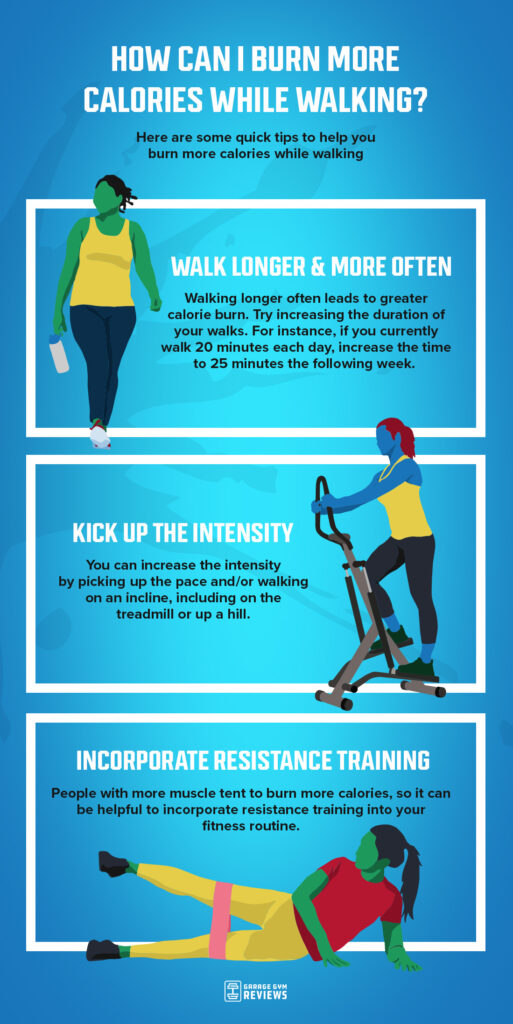
Walk Longer And/Or More Often
Because walking longer often leads to greater calorie burn, try increasing the duration of your walks. For instance, if you walk 20 minutes every day, try doing 25 minutes. As your body acclimates to longer walks, gradually increase your walking time.
You can also split your daily walks into two shorter jaunts, such as doing one 30-minute walk in the morning and another half-hour trek that evening.
Kick Up The Intensity
Intensity greatly impacts how many calories you burn while walking, so try kicking your workouts up a notch. You can increase the intensity by picking up the pace and/or walking on an incline, including on the treadmill or up a hill.
Carrying or pushing weight can also increase the intensity of your walk. This could be by pushing your little one in a stroller or wearing a weighted vest or backpack.
Please note it’s important to add weight or resistance to your walks carefully and with caution. Carrying too much weight or disproportionally distributing the weight on your body can lead to muscle imbalances or postural deviations, and subsequent injury.
Incorporate Resistance Training
This walking tip is more of a long-term investment, but the payoff is well worth it! Because people with more muscle tend to burn more calories, it can be helpful to incorporate resistance training into your fitness routine.
In addition to increasing muscle mass and metabolism over time, resistance training can enhance your strength to power through more intense and longer workouts.
Resistance training is important but not as important as doing so safely! Especially if new to resistance training, consider working with a certified personal trainer (CPT).
Factors That Affect Calories Burned While Walking
Many factors affect calories burned while walking, including personal factors and ones related to the walk itself. These factors consider body size and body composition, as well as the duration and pace of the walk.
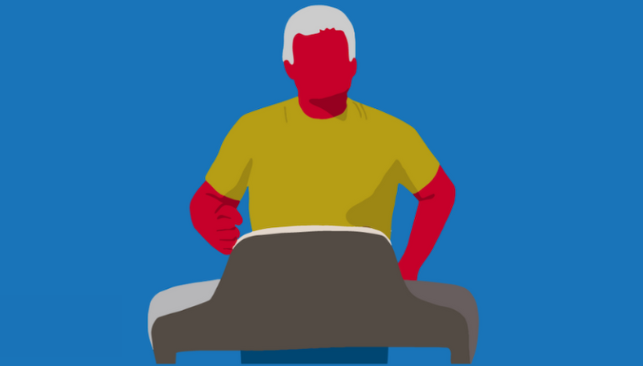
Body Size And Body Composition
A 2014 review published in the Frontiers in Nutrition3 suggests body size and body composition impact basal metabolic rate (BMR) and total energy expenditure (TEE). Because bigger individuals have more body tissue, or simply weigh more, they’re going to burn more calories.
Body composition, or one’s proportion of fat and muscle mass, can also impact energy expenditure3.
Adipose tissue, or fat cells, expend less energy than skeletal muscle. What this means is that if two people each weigh 200 pounds, the one with more muscle mass will likely burn more calories.
Biological Gender And Age
Women’s metabolic rate is about 5 to 10% lower than men’s, according to a ScienceDirect4 overview, even when they’re of the same bodyweight and height.
While the Cornell University’s METS to Calories Calculator does not consider biological age and gender, each greatly impacts calorie burn. This is mostly due to differences in their body size and composition. This might be due to the fact that women tend to carry more body fat and less skeletal muscle than men.
Changing body composition is also the largest physiological factor as you get older. Muscle mass gradually declines with age4, particularly in physically inactive people, which naturally lowers energy expenditure.
What’s interesting, though, is that most studies have not found consistent differences in walking energy expenditure between adults based on age and gender, according to a 2010 meta-analysis in Procedia – Social and Behavioral Sciences5, and that some studies actually showed that females have higher energy expenditure due to shorter stride lengths.
Walking Duration, Pace, And Intensity
The longer you’re actively moving your body, generally the more calories your body burns. So the longer a walk you take, the more calories you can generally expect to burn.
Increasing the intensity, including by increasing the pace, also influences calorie burn. Based on the chart above, incrementally increasing the pace increases the number of calories burned.
Along with walking pace, walking on an incline can increase intensity and calorie burn. Using Cornell’s calculator, a 200-pound individual will burn about 240 calories in 30 minutes by walking up a hill with a 1 to 5% grade. This is about 80 extra calories burned compared to if they walked on a firm surface at a moderate pace for the same amount of time.
You can increase the intensity of a workout by adding resistance, too. Someone who pushes or pulls a stroller for 30 minutes expends about 181 calories. If that same person climbed a hill with 10 to 20 pounds for 30 minutes, they could burn around 330 calories.
Can Walking Help You Lose Weight?
While fitness is and should be much more than a weight-loss tactic, people often turn to exercise in hopes to burn calories and lose weight. In fact, the CDC6 reports that 62.9% of adults trying to lose weight used exercise as a weight-loss method.
The adults might’ve taken the weight loss advice to “Eat less and move more” to heart… The same percentage of adults reported “eating less” as a common weight loss method!

For true fat loss and health benefits, combining the two tactics yields the best results. Based on a 2007 meta-analysis in the Journal of American Dietetic Association7, exercise alone leads to minimal weight loss.
A more recent 2014 meta-analysis in the Journal of the Academy of Nutrition and Dietetics8 suggests programs based on physical activity alone are less effective than combined behavioral weight management programs (BWMPs) in both the short and long-term. Taken together, this reiterates the fact losing body fat relies on sustainable behavior changes.
Is Walking Good Exercise?
Any exercise is great exercise and better than going without! Walking is also one of the most accessible forms of exercise— it’s essentially free of charge, requires no equipment except clothes and shoes, and can be done just about anywhere.
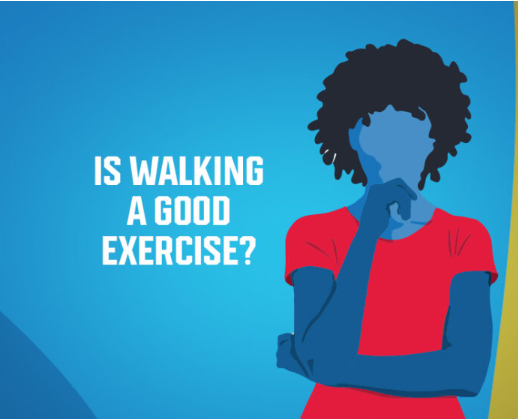
The Physical Activity Guidelines for Americans suggest regular exercise, walking included, can benefit just about anyone. Research shows regular physical activity can:
- Reduce blood pressure and total cholesterol levels
- Improve sleep
- Decrease feelings of anxiety and depressive symptoms
- Increase cardiorespiratory fitness and muscular strength
- Delay or prevent chronic diseases, including hypertension, type 2 diabetes, and certain types of cancers
- Encourage independence
- Improve insulin sensitivity and blood sugar control
Research also shows walking in a group11, outdoors12, and with your dog13 may improve health outcomes. As you can see, the benefits are worth stepping into but how much walking is considered “good?”
RELATED: Best walking shoes for seniors
How Much Walking Is “Good?”
According to a 2020 systematic review published in the International Journal of Behavioral Nutrition and Physical Activity14, walking an additional 1,000 steps per day can help lower the risk of all-cause mortality and cardiovascular morbidity/mortality in adults. Health benefits are present below 10,000 steps per day as well.
Another 2023 meta-analysis in Lancet Public Health15 shows the risk of premature death levels off at about 6,000-8,000 steps per day in older adults, meaning more steps might not offer additional benefit for longevity. Adults younger than 60 saw the risk of premature death stabilize at about 8,000-10,000 steps per day.
For substantial health benefits, the Physical Activity Guidelines recommends:
- 150 minutes (2.5 hours) to 300 minutes (5 hours) a week of moderate-intensity aerobic exercise, including a brisk walk
- 75 minutes (1 hour and 15 minutes) to 150 minutes (2.5 hours) a week of vigorous-intensity aerobic physical activity
- An equivalent combination of moderate- and vigorous-intensity aerobic activity.
The guidelines further hint additional health benefits are gained by engaging in 300 minutes (5 hours) of moderate-intensity physical activity a week.
The time dedicated to physical activity may seem like a lot, though the guidelines encourage spreading aerobic activity throughout the week. And when you put these numbers into perspective, the minimum 2.5-hour general recommendation is less than 1.5 percent of your total week (while gaining tremendous benefit)!
Final Thoughts: How Many Calories Does Walking a Mile Burn?
The amount of calories burned while walking depends on various factors, including body size, age, walking pace, and the intensity of the walk. Calculating your average calorie burn can be a helpful metric to know, although calories don’t tell the full story of your fitness journey.
Walking can truly support your health and wellness in many ways, especially when swapping a walk with sedentary behaviors (looking at you, Netflix)! So the next time someone tells you to “take a walk,” happily oblige and step to the many benefits of such a universally accepted and appreciated exercise.
Experts Who Contributed
FAQ: How Many Calories Does Walking a Mile Burn
How many calories does a 2 mile walk burn?
A 200-pound man will burn 106 calories during a 2-mile walk, whereas a 170-pound women will burn 90.6 calories. Factors such as biological sex, age, muscle mass, and intensity will impact how many calories you burn during a walk.
How many miles should I walk to burn 500 calories?
A 200-pound man will have to walk for about four-and-a-half miles to burn 500 calories, but factors such as muscle mass, age, and intensity may move that number up or down.
Can you lose belly fat by walking?
Absolutely! Walking is a great way to increase your caloric expenditure, which could lead to losing belly fat if you remain in a slight caloric deficit.
How long should you walk to lose weight?
The American College of Sports Medicine9 recommends 200 to 300 minutes of exercise per week to facilitate long-term weight management. This amounts to a little less than 45 minutes per day on the high end and 5 hours total each week.
According to the Physical Activity Guidelines for Americans10, people who want to lose more than 5% of body weight need more than 300 minutes of moderate-intensity activity a week to meet their goals. Those who lost a significant amount of weight and are trying to keep it off might need more than 300 minutes each week, too.
References
- Harvard Health Publishing, Harvard Medical School. Calories burned in 30 minutes for people of three different weights. 2021;08(3).
- Centers for Disease Control and Prevention. Anthropometric Reference Data for Children and Adults: United States, 2015–2018. 2021;46(3).
- Hills AP, Mokhtar N, Byrne NM. Assessment of physical activity and energy expenditure: an overview of objective measures. Front Nutr. 2014;1:5. Published 2014 Jun 16. doi:10.3389/fnut.2014.00005
- ScienceDirect. Resting Metabolic Rate – an overview.
- Abadi FH, Muhamad TA, Salamuddin N. Energy expenditure through walking: Meta Analysis on gender and age. Procedia Soc Behav Sci. 2010;7:512-521. doi:10.1016/j.sbspro.2010.10.069
- Centers for Disease Control and Prevention. Data Brief 313. Attempts to Lose Weight Among Adults in the United States, 2013–2016.
- Franz MJ, VanWormer JJ, Crain AL, et al. Weight-loss outcomes: a systematic review and meta-analysis of weight-loss clinical trials with a minimum 1-year follow-up. J Am Diet Assoc. 2007;107(10):1755-1767. doi:10.1016/j.jada.2007.07.017
- Johns DJ, Hartmann-Boyce J, Jebb SA, Aveyard P; Behavioural Weight Management Review Group. Diet or exercise interventions vs combined behavioral weight management programs: a systematic review and meta-analysis of direct comparisons. J Acad Nutr Diet. 2014;114(10):1557-1568. doi:10.1016/j.jand.2014.07.005
- Jakicic JM, Clark K, Coleman E, et al. American College of Sports Medicine position stand. Appropriate intervention strategies for weight loss and prevention of weight regain for adults. Med Sci Sports Exerc. 2001;33(12):2145-2156. doi:10.1097/00005768-200112000-00026
- U.S. Department of Health and Human Services. Physical Activity Guidelines for Americans, 2nd edition. 2018.
- ScienceDirect. Walking Speed – an overview.
- Hanson S, Jones A. Is there evidence that walking groups have health benefits? A systematic review and meta-analysis. Br J Sports Med. 2015;49(11):710-715. doi:10.1136/bjsports-2014-094157
- Legrand FD, Jeandet P, Beaumont F, Polidori G. Effects of outdoor walking on positive and negative affect: Nature contact makes a big difference. Front Behav Neurosci. 2023;16. doi:10.3389/fnbeh.2022.901491
- Christian H, Bauman A, Epping JN, et al. Encouraging Dog Walking for Health Promotion and Disease Prevention. Am J Lifestyle Med. 2016;12(3):233-243. Published 2016 Apr 17. doi:10.1177/1559827616643686
- Hall KS, Hyde ET, Bassett DR, et al. Systematic review of the Prospective Association of Daily Step Counts with risk of mortality, cardiovascular disease, and dysglycemia. Int J Behav Nutr Phys Act. 2020;17(1). doi:10.1186/s12966-020-00978-9
- Paluch AE, Bajpai S, Bassett DR, et al. Daily steps and all-cause mortality: a meta-analysis of 15 international cohorts. Lancet Public Health. 2023;7(3):e219-e228. doi:10.1016/S2468-2667(21)00302-9
- Williams PT, Thompson PD. Walking versus running for hypertension, cholesterol, and diabetes mellitus risk reduction. Arterioscler Thromb Vasc Biol. 2013;33(5):1085-1091. doi:10.1161/atvbaha.112.300878


